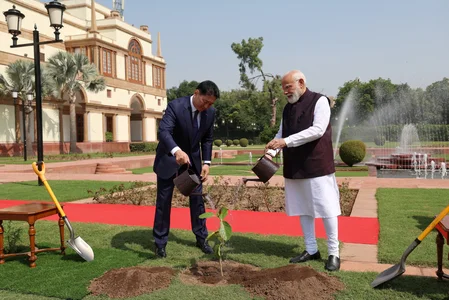Now Reading: PM Modi and Mongolian President Plant Sapling to Strengthen Environmental Ties
-
01
PM Modi and Mongolian President Plant Sapling to Strengthen Environmental Ties
PM Modi and Mongolian President Plant Sapling to Strengthen Environmental Ties

In a symbolic gesture of environmental commitment, Prime Minister Narendra Modi and Mongolian President Khurelsukh Ukhnaa jointly planted a sapling at Hyderabad House in New Delhi. This act underlines the shared dedication of both leaders to environmental sustainability and reflects the growing diplomatic and cultural ties between India and Mongolia.
A Shared Commitment to the Environment
The tree planting ceremony was more than a ceremonial act; it represented a convergence of two significant environmental initiatives. Prime Minister Modi’s ‘Ek Ped Maa Ke Naam’ campaign encourages individuals to plant trees in honor of their mothers, fostering a personal connection to nature. President Ukhnaa’s ‘One Billion Trees’ initiative aims to combat climate change by significantly increasing tree cover in Mongolia. This collaboration highlights the importance of cross-border environmental efforts and the role of leadership in promoting ecological responsibility.
Strengthening Bilateral Relations
The event also marked the first official meeting between the two leaders, setting the stage for deeper cooperation. Discussions covered various aspects of the India-Mongolia relationship, including strategic partnerships, trade, education, and cultural exchanges. The planting of the sapling served as a poignant symbol of the growing friendship and mutual respect between the two nations.
Cultural and Diplomatic Significance
Beyond the environmental message, the ceremony held cultural importance. President Ukhnaa planted a banyan tree in memory of his late mother, adding a personal and emotional dimension to the event. This act resonated with India’s deep-rooted cultural reverence for nature and motherhood, bridging the two countries’ shared values and traditions.
Conclusion
The joint tree planting by Prime Minister Modi and President Ukhnaa at Hyderabad House was more than a diplomatic gesture; it was a testament to the strengthening of India-Mongolia relations. By aligning their environmental initiatives, both leaders have set a precedent for international cooperation in addressing global ecological challenges. This collaboration not only contributes to environmental conservation but also deepens the cultural and diplomatic ties between the two nations.

























